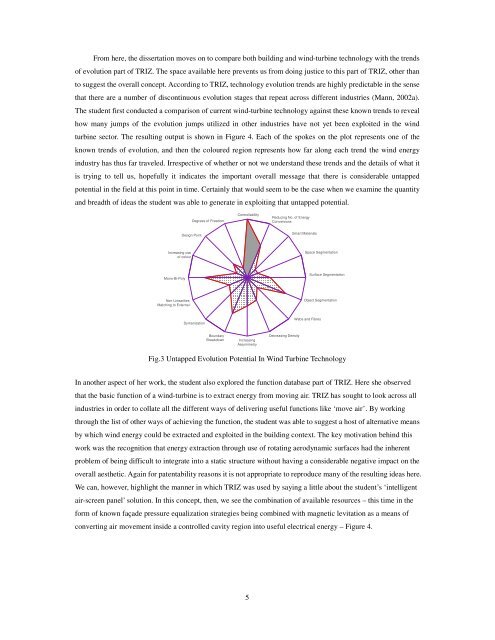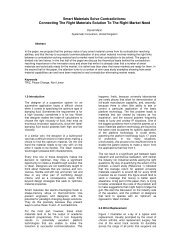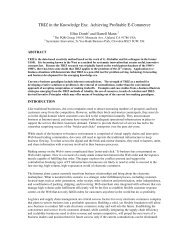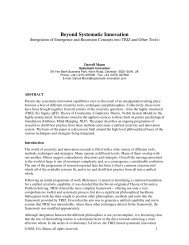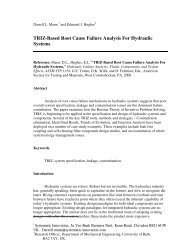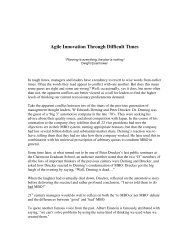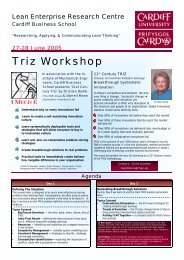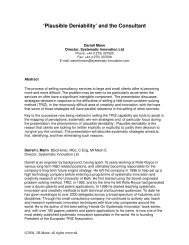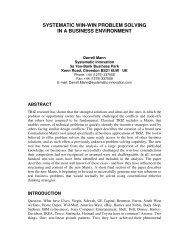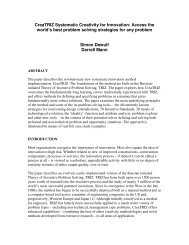Using TRIZ In Architecture: First Steps - Systematic Innovation
Using TRIZ In Architecture: First Steps - Systematic Innovation
Using TRIZ In Architecture: First Steps - Systematic Innovation
You also want an ePaper? Increase the reach of your titles
YUMPU automatically turns print PDFs into web optimized ePapers that Google loves.
From here, the dissertation moves on to compare both building and wind-turbine technology with the trends<br />
of evolution part of <strong>TRIZ</strong>. The space available here prevents us from doing justice to this part of <strong>TRIZ</strong>, other than<br />
to suggest the overall concept. According to <strong>TRIZ</strong>, technology evolution trends are highly predictable in the sense<br />
that there are a number of discontinuous evolution stages that repeat across different industries (Mann, 2002a).<br />
The student first conducted a comparison of current wind-turbine technology against these known trends to reveal<br />
how many jumps of the evolution jumps utilized in other industries have not yet been exploited in the wind<br />
turbine sector. The resulting output is shown in Figure 4. Each of the spokes on the plot represents one of the<br />
known trends of evolution, and then the coloured region represents how far along each trend the wind energy<br />
industry has thus far traveled. Irrespective of whether or not we understand these trends and the details of what it<br />
is trying to tell us, hopefully it indicates the important overall message that there is considerable untapped<br />
potential in the field at this point in time. Certainly that would seem to be the case when we examine the quantity<br />
and breadth of ideas the student was able to generate in exploiting that untapped potential.<br />
Degrees of Freedom<br />
Controllability<br />
Reducing No. of Energy<br />
Conversions<br />
Design Point<br />
Smart Materials<br />
<strong>In</strong>creasing use<br />
of colour<br />
Space Segmentation<br />
Mono-Bi-Poly<br />
Surface Segmentation<br />
Non-Linearities<br />
Matching to External<br />
Object Segmentation<br />
Dymanization<br />
Webs and Fibres<br />
Boundary<br />
Breakdown<br />
<strong>In</strong>creasing<br />
Assymmetry<br />
Decreasing Density<br />
Fig.3 Untapped Evolution Potential <strong>In</strong> Wind Turbine Technology<br />
<strong>In</strong> another aspect of her work, the student also explored the function database part of <strong>TRIZ</strong>. Here she observed<br />
that the basic function of a wind-turbine is to extract energy from moving air. <strong>TRIZ</strong> has sought to look across all<br />
industries in order to collate all the different ways of delivering useful functions like ‘move air’. By working<br />
through the list of other ways of achieving the function, the student was able to suggest a host of alternative means<br />
by which wind energy could be extracted and exploited in the building context. The key motivation behind this<br />
work was the recognition that energy extraction through use of rotating aerodynamic surfaces had the inherent<br />
problem of being difficult to integrate into a static structure without having a considerable negative impact on the<br />
overall aesthetic. Again for patentability reasons it is not appropriate to reproduce many of the resulting ideas here.<br />
We can, however, highlight the manner in which <strong>TRIZ</strong> was used by saying a little about the student’s ‘intelligent<br />
air-screen panel’ solution. <strong>In</strong> this concept, then, we see the combination of available resources – this time in the<br />
form of known façade pressure equalization strategies being combined with magnetic levitation as a means of<br />
converting air movement inside a controlled cavity region into useful electrical energy – Figure 4.<br />
5


